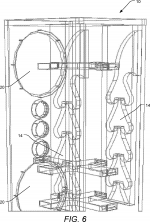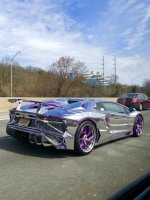I just keep wondering about the U.S Patent office's quality control of it's own work...
US9247339B2 - Loudspeaker design
- Google Patents
I can understand that there are many people that get enchanted by this kind of claims. For example check who won the Presidential election last time...
US9247339B2 - Loudspeaker design
- Google Patents
I can understand that there are many people that get enchanted by this kind of claims. For example check who won the Presidential election last time...
Same Guy
WO2017106881
A loudspeaker incorporates a fluid diode in an air path of a loudspeaker enclosure, allowing an internal loudspeaker enclosure air density and pressures to be fluidically controlled and cycled through the loudspeaker enclosure. Air is drawn into the enclosure through the fluid diode, and is pushed out of the enclosure through a second fluid diode.
a speaker that sucks and blows?
WO2017106881
A loudspeaker incorporates a fluid diode in an air path of a loudspeaker enclosure, allowing an internal loudspeaker enclosure air density and pressures to be fluidically controlled and cycled through the loudspeaker enclosure. Air is drawn into the enclosure through the fluid diode, and is pushed out of the enclosure through a second fluid diode.
a speaker that sucks and blows?
Attachments
There are patents out there for faster-than-light communications sent through a different dimension. Granted, too. Patents only have to be original. There is no obligation that they should actually work. The ones that aggravate me tend to be patents granted for things that have been in the public domain for decades (patent examiner not doing their job properly). Yes, they could be challenged, but that means potential court action, which in turn requires money.
Last edited:
a speaker that sucks and blows?
Sounds like a quote from Spaceballs.
'Sir, it's Megamaid: she's gone from suck to blow!'
a speaker that sucks and blows?
Just imagine what it would do if it wouldn't blow as well ! It would only ....... !!
Regards
Charles
Of course he deserves to be ruthlessly mocked for his techno-poetry. But!
Pinheads mocking him on the internet SELLS.
Patents SELL.
Marketing drivel SELLS.
Speakers that are easy loads and play loudly SELL.
He's not unhappy with a dis-favorable rating from us tire kickers.
Yeah,Zu audio is a prime example of horrible designs which has been selling for 15years. Owners imply its just a matter of opinion and taste.. Imagine telling your teacher at school "well thats just like your opinion man..."
Many years ago, I remember reading about a new type of subwoofer that used a magnet and coil to pivot a paddle that formed one wall of a tapered box, so that it would alternately suck or squeeze air out of the box.a speaker that sucks and blows?
The hope was to provide more efficient coupling to the air than you get from a conventional woofer, and so be able to produce adequate SPL at very low frequencies without having to use a huge driver and huge enclosure.
Evidently the idea didn't last long in production, for reasons I can only guess at.
-Gnobuddy
The problem is that if you spread tweeters out over a fairly large area (as these speakers do), then the individual tweeters are all at slightly different distances from your ear.Acoustically the phase from one tweeter to another may not be good, but if you add all of them up, any phase variation may cancel each other out.
What this means is that the phase produced by each tweeter at your ear, due to the differing path lengths, is different. This causes erratic peaks and dips in the frequency response.
This problem is not caused by imperfect tweeters - it's caused by the different path lengths. Using multiple tweeters spread over an area makes it worse, not better. You need the smallest source possible, which is 1 tweeter.
I should add that path length differences are not a problem if the wavelengths of the reproduced sounds are much larger than the slightly differing path length distances. But, for tweeters, this is never the case - acoustic wavelengths are surprisingly small at the top end of the audio spectrum, only 1.35" at 10 kHz, for instance. So even small path length differences mess up the frequency response at your ear.
Planet10 quoted a rough rule of thumb earlier - a good design keeps the drivers are separated by no more than one-quarter of the shortest wavelength they produce. At 10 kHz, that means two drivers (tweeters) would have to be no further than one-third of an inch apart. Which is impossible, because we don't have tweeters smaller than 1/3 inch!
So the best you can do is use a single tweeter. In fact our smallest tweeters are really already too big for good dispersion at 20 kHz. A 1/4" or 1/6" diameter tweeter would be better. But nobody knows how to make one that small that is still capable of producing enough SPL!
(The same size problem affects microphones too - smaller is better for accurate high-frequency response. Luckily, manufacturers can and do make microphones much smaller than tweeters - all good audio measurement microphones have diaphragms much smaller than the typical 1" size of a tweeter.)
-Gnobuddy
In fairness it's also a 4-way design, so assuming they are being accurate with that definition (just assuming), then you've got the woofer pair & the quad of midrange units making up two legs of that. Presumably the majority of the hexagonal tweeter arrays are used as upper midranges before handing off to one or a small number (say 3) tweeters for the final HF leg. I don't see any intrinsic functional issue with doing that -I just don't see any technical advantage either unless they are doing something very fancy with the wiring to the upper-mid & HF units to provide some directivity control (frankly I doubt it, but having no evidence one way or the other, this has to be chalked up as an unknown). It does give them a big impressive looking box with a shed-load of drivers of course, a la the 'kabuki' speakers of the '70s.
What’s wrong with a full range driver augmented with a tweeter and high-pass cap? Isn’t this basically the core of many high efficiency speakers?Yeah,Zu audio is a prime example of horrible designs which has been selling for 15years. Owners imply its just a matter of opinion and taste.. Imagine telling your teacher at school "well thats just like your opinion man..."
nothing if you want horrid polar response and high distortion. on-axis response also completely random. then forget anything close to low freq.
all of their designs are imo laughable
Zu Audio - What is Going On? | Audio Science Review (ASR) Forum
Zu Essence Floor Standing Speakers
all of their designs are imo laughable
Zu Audio - What is Going On? | Audio Science Review (ASR) Forum
Zu Essence Floor Standing Speakers
What’s wrong with a full range driver augmented with a tweeter and high-pass cap? Isn’t this basically the core of many high efficiency speakers?
A FR augmented with a woofer works way better IMO.
dave
(snip) Presumably the majority of the hexagonal tweeter arrays are used as upper midranges before handing off to one or a small number (say 3) tweeters for the final HF leg. I don't see any intrinsic functional issue with doing that -I just don't see any technical advantage either unless they are doing something very fancy with the wiring to the upper-mid & HF units to provide some directivity control (frankly I doubt it, but having no evidence one way or the other, this has to be chalked up as an unknown). It does give them a big impressive looking box with a shed-load of drivers of course, a la the 'kabuki' speakers of the '70s.
At least there are improvements in efficiency, power handling, and reduced excursion from having multiple drivers.
And it looks like you're actually getting something for your money.
Exactly!It does give them a big impressive looking box with a shed-load of drivers of course, a la the 'kabuki' speakers of the '70s.
Last night I watched a couple of episodes of a Netflix show called "Fastest Car". One episode featured a chrome-plated Lamborghini owned by a clearly very psychologically damaged (but also very rich) divorce lawyer.
The chrome-plated Lambo came with a girlfriend, but I think I'm going to steer well clear of that topic.
Anyway, for some odd reason, the chrome-plated Lamborghini (pics attached) reminds me of the Tekton speakers we're discussing. I can't imagine why.
-Gnobuddy
Attachments
- Status
- This old topic is closed. If you want to reopen this topic, contact a moderator using the "Report Post" button.
- Home
- Loudspeakers
- Multi-Way
- Tekton is using up all the Beryllium!



